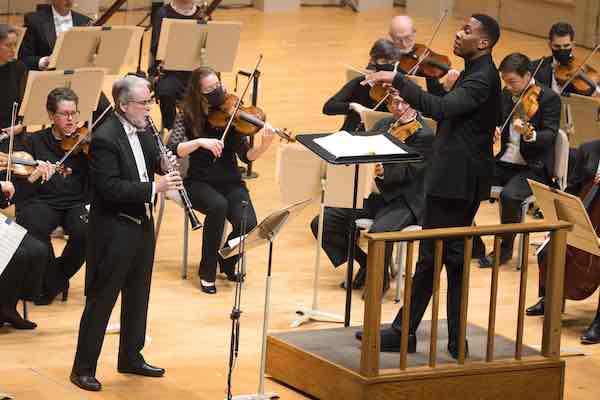Cox makes strong Boston Symphony debut with Mozart and Mendelssohn

William R. Hudgins performed Mozart’s Clarinet Concerto with Roderick Cox leading the BSO Thursday night. Photo: Hilary Scott
The Boston Symphony Orchestra’s concerts this month have showcased an array of podium guests. Yet none struck a finer impression than Roderick Cox, who made his BSO debut Thursday night at Symphony Hall.
The Berlin-based American conductor has enjoyed a meteoric rise. With his commanding presence and fluid direction Thursday night it is easy to see why.
Cox mined dramatic subtleties in the program of Mendelssohn and Mozart with a keen eye to musical detail. His broad sweeping gestures teased out sudden crescendos from the gentlest of phrases. Sudden lunges resulted in robust accents yet he maintained focus on the big picture. All qualities were on display in the performance of Mendelssohn’s Symphony No. 3, “Scottish.”
Though it contains no overt program, Mendelssohn’s “Scottish” symphony casts vivid images of an ancient landscape. The work’s dark scoring and rough-hewn harmonies capture in sound the ivy-covered Edinburgh chapel that inspired its conception.
Cox treated the symphony as a gripping journey from storm and stress to a concluding peace. The slow introduction set an aptly atmospheric scene as string and woodwind lines rose and fell away. His fleet tempos in the ensuing Allegro resulted in roiling intensity. But Cox took time to revel in the passing woodwind phrases, his tasteful rubato bringing a sense of both darkness and grandeur.
The Scherzo moved urgently, with the familiar clarinet solo—Mendelssohn’s vision of Scottish folksong—etched with tasteful lyricism. Similar chamber-like delicacies abounded in the third movement. Violin and viola lines brought warm resonance; French horns answered with phrases of hushed power. The slow march that emerged mid-movement swelled to grand statements before fading in the serene closing bars.
The finale’s main theme bounded with live-wire energy that momentarily broke its tension in the haunting horn calls. All turned to light in the coda, which brought the symphony to a warm-hearted conclusion.
The concert’s opener, Mozart’s Clarinet Concerto, provided a delicate complement. The evening’s soloist was BSO principal clarinetist William R. Hudgins, who delivered a svelte and intimate reading.
Mozart’s concerto offers more lyricism than technical fireworks. Yet Hudgins’s performance conveyed the subtle emotional tension that lies just beneath the surface of this music. Playing with the score, Hudgins found the soft elegance of the opening phrases, his silky tone revealing every curve of the melodic arc. He rendered the cascading runs with songlike grace. The second theme brought greater contrast as Hudgins’s amber-rich tone carried just a touch of angst.
The Rondo coursed with dance-like energy. Hudgins found a virtuosic flair as he tossed off the runs and wide leaps with aplomb. Sudden dynamic shifts brought additional urgency, which carried into the concluding flurry.
Hudgins’s playing was most tender in the arresting Adagio. Serene harmonies in the orchestra supplied the foundation for the clarinetist’s fluid lines, and he unfolded the melody with an enveloping, operatic warmth. Yet Hudgins found the disquieting moments that often go unheard in performances of this score. Passages in his instrument’s low register briefly tipped the music toward darkness. When he reprised the main theme, Hudgins’s playing was utterly soft and beautiful, the music carrying its vigor through the faintest of whispers.
Cox drew a sensitive and well-balanced accompaniment that wrapped Hudgins in a warm blanket of sound. The resplendent performance made this a Mozart to relish. The audience seemed to agree and rewarded the musicians with rapturous applause.
The program will be repeated 1:30 p.m. Friday and 8 p.m. Saturday at Symphony Hall. bso.org
Posted in Performances



